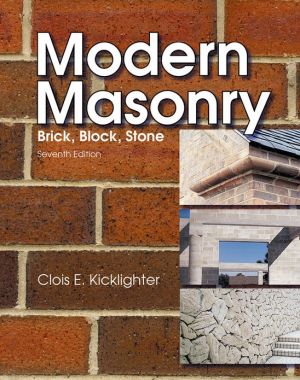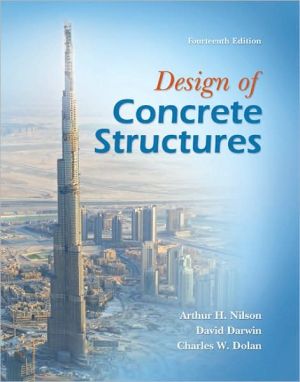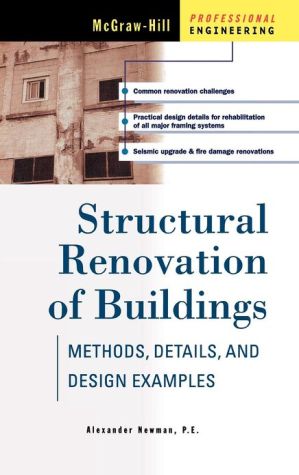Reinforced Concrete: Mechanics and Design
Reinforced Concrete Mechanics & Design Fifth Edition James K. Wight • James G. MacGregor \ A multi-tiered approach makes Reinforced Concrete: Mechanics and Design an outstanding textbook for a variety of courses on reinforced concrete design.\ This new edition has been updated so all chapters are in compliance with the 2008 edition of the ACI Building Code. New problems were developed for chapters where major changes were made, and all of the examples throughout the text were either...
Search in google:
This book explains the theory and practice of reinforced concrete design in a systematic and clear fashion with an abundance of step-by-step worked examples, illustrations, and photographs.This book focuses on preparing readers to make the many judgment decisions required in reinforced concrete design. All chapters are in compliance with 2008 Edition of ACI Building Code. Coverage includes flexure, torsion, continuous beams, columns, two-way slabs, footing, walls, design for earthquake resistance, and more.For professionals in the field who need a comprehensive reference on concrete structures and the design of reinforced concrete
Preface Reinforced concrete design encompases both the art and science of engineering. This book presents the theory of reinforced concrete as a direct application of the laws of statics and mechanics of materials. In addition, it emphasizes that a successful design not only satisfies design rules, but also is capable of being built in a timely fashion and for a reasonable cost. Philosophy of Reinforced Concrete: Mechanics and Design A multi-tiered approach makes Reinforced Concrete: Mechanics and Design an outstanding textbook for a variety of university courses on reinforced concrete design. Topics are normally introduced at a fundamental level, and then move to higher levels where prior educational experience and the development of engineering judgment will be required. The analysis of the flexural strength of beam sections is presented in Chapter 4. Because this is the first significant design-related topic, it is presented at a level appropriate for new students. Closely related material on the analysis of column sections for combined axial load and bending is presented in Chapter 11 at a somewhat higher level, but still at a level suitable for a first course on reinforced concrete design. Advanced subjects are also presented in the same chapters at levels suitable for advanced undergraduate or graduate students. These topics include, for example, the complete moment versus curvature behavior of a beam section with various tension reinforcement percentages and the use strain-compatibility to analyze either over-reinforced beam sections, or column sections with multiple reinforcement layers. More advanced topics are covered in the later chapters, making this textbook valuable for both undergraduate and graduate courses, as well as serving as a key reference in design offices. Other features include the following: 1.¿¿Extensive figures are used to illustrate aspects of reinforced concrete member behavior and the design process. 2.¿¿Emphasis is placed on logical order and completeness for the many design examples presented in the book. 3.¿¿Guidance is given in the text and in examples to help students develop the engineering judgment required to become a successful designer of reinforced concrete structures. 4. Chapters 2 and 3 present general information on various topics related to structural design and construction, and concrete material properties. Frequent references are made back to these topics throughout the text. Overview¿What Is New in the Fifth Edition? Professor Wight was the primary author for this edition and has made several changes in the coverage of various topics. One of the most significant changes was the updating of all chapters to be in compliance with the 2008 edition of the ACI Building Code. New problems were developed for chapters where major changes were made, and all of the examples throughout the text were either reworked or checked for accuracy. Other changes include the following: 1. All flexural analysis of various beam and slab sections is now covered in Chapter 4. Previously this material was given in three different chapters. After completing this chapter students should be prepared to analyze any beam section they may encounter either in their courses or in a design office. 2. All flexural design for beams and one-way slabs is covered in Chapter 5. Information on continuous floor systems, which was in Chapter 10 of prior editions, has been moved to Chapter 5. Also, Chapter 5 gives more extensive information on structural analysis of continuous floor systems, including modeling assumptions and the interplay between analysis and design. 3. Chapter 12 has been significantly modified to comply with changes in the ACI Code for analysis and design of slender columns. A new detailed design example is included to demonstrate the new code provisions. 4. Chapter 13 includes all of the analysis and design requirements for two-way floor systems, which was previously presented in two chapters. As with Chapter 5, this chapter includes new information on structural analysis and modeling assumptions for continuous two-way floor systems. The historic introduction for this topic and the detailed design examples have been retained. 5. An expanded coverage of the yield-line analysis method for two-way slabs, including several examples, is presented in Chapter 14. 6. In Chapter 18 the discussion of flexural design procedures for shear walls that resist lateral loads, including walls with either uniformly distributed vertical reinforcement or with vertical reinforcement concentrated at the edges of the wall section, has been expanded. Also, a capacity-design approach is presented for the shear design of structural walls that resist earthquake-induced forces. 7. Appendix A now contains a large number of axial load vs. moment interaction diagrams that incorporate the strength reduction factor. Both students and designers should find these figures very useful. Use of textbook in Undergraduate and Graduate Courses The following paragraphs give a suggested set of topics and chapters to be covered in the first and second reinforced concrete design courses, normally given at the undergraduate and graduate levels, respectively. It is assumed that these are semester courses. First Design Course: Chapters 1 through 3 should be assigned, but the detailed information on loading in Chapter 2 can be covered in a second course. The extensive information on concrete material properties in Chapter 3 could be covered in a separate undergraduate course. Chapters 4 and 5 are extremely important for all students and should form the foundation of the first undergraduate course. The information in Chapter 4 on moment vs. curvature behavior of beam sections is important for all designers, but this topic could be significantly expanded in a graduate course. Chapter 5 presents a variety of design procedures for developing efficient designs of either singly-reinforced or doubly-reinforced sections. The discussions of structural analysis for continuous floor systems could be skipped if either time is limited or if students are not yet prepared to handle this topic. The first undergraduate course should cover the Chapter 6 information on member behavior in shear and the shear design requirements given in the ACI Code. Discussions of other methods for determining the shear strength of concrete members can be saved for a second design course. Design for torsion, as covered in Chapter 7, could be covered in a first design course, but more often is left for a second design course. The anchorage provision of Chapter 8 are important material for the first undergraduate design course. Students should develop a basic understanding of development length requirements for straight and hooked bars, as well as the procedure to determine bar cut-off points and the details required at those cut-off points. The serviceability requirements in Chapter 9 for control of deflections and cracking are also important topics for the first undergraduate course. In particular, the ability to do an elastic section analysis and find moments of inertia for cracked and uncracked sections is an important skill for designers of concrete structures. Chapter 10 serves to tie together all of the requirements for continuous floor systems introduced in Chapters 5 through 9. The examples include details for flexural and shear design, as well as full-span detailing of longitudinal and transverse reinforcement. This chapter could either be skipped for the first undergraduate course, or could be used as a source for a more extensive class design project. Chapter 11 concentrates on the analysis and design of columns sections, and should be included in the first undergraduate course. The portion of Chapter 11 that covers column sections subjected to biaxial bending may either be included in a first undergraduate course or saved for a graduate course. Chapter 12 considers slenderness effects in columns and the more detailed analysis required for this topic is commonly presented in a graduate course. If time permits, the basic information in Chapter 15 on the design of typical concrete footings may be included in a first undergraduate course. This material may also be covered in a foundation design course taught at either the undergraduate or graduate level. Second Design Course: Clearly, the instructor in a graduate design course has many options for topics, depending on his/her interests and the preparation of the students. Chapter 13 is a massive chapter and is clearly intended to be a significant part of a graduate course. The chapter gives extensive coverage of flexural analysis and design that builds on the analysis and design of one-way floor systems covered in Chapter 5. The direct design method and the classic equivalent frame method are discussed, along with more modern analysis and modeling techniques for two-way floor systems. Problems related to punching shear and the combined transfer of shear and moment at slab-to-column connections are covered in detail. The design of slab shear reinforcement, include the use of shear studs, is also presented. Finally, procedures for calculating deflections in two-way floor systems are given. Design for torsion, as given in Chapter 7, should be covered in conjunction with the design and analysis of two-way floor systems in Chapter 13. The design procedure for compatibility torsion at the edges of a floor system has a direct impact on the design of adjacent floor members. The presentation of the yield-line method in Chapter 14, gives students an alternative analysis and design method for two-way slab systems. This topic could also tie in with plastic analysis methods taught in graduate level analysis courses. The analysis and design of slender columns, as presented in Chapter 12, should also be part of a graduate design course. The students should be prepared to apply the frame analysis and member modeling techniques required to either directly determine the secondary moments or calculate the required magnification factors. Also, if the topic of biaxial bending was not covered in the first design course, it could be included at this point. Chapter 18 covers bending and shear design of structural walls that resist lateral loads due to either wind or seismic effects. A capacity-design approach is introduced for the shear design of walls that resist earthquake-induced lateral forces. Chapter 17 covers the concept of disturbed regions (D-regions), and the use of the strut-and-tie models to analyze the flow of forces through D-regions and to select appropriate reinforcement details. The chapter contains detailed examples to help students learn the concepts and code requirements for strut-and-tie models. If time permits, instructors could cover the design of combined footings in Chapter 15, shear-friction design concepts in Chapter 16, and design to resist earthquake-induced forces in Chapter 20. Acknowledgments and Dedication This book is dedicated to all the colleagues and students who have either interacted with and taken classes from professors Wight and MacGregor over the years. Our knowledge of analysis and design of reinforced concrete structures were enhanced by our interactions with all of you. Professor Wight would like to especially thank his students who read the new chapters and sections included in this edition of the textbook. The manuscript of the entire Fifth Edition book was reviewed by Sharon Wood and Cathy French, both of whom are active members of ACI Committee 318. It was also thoroughly reviewed by Dr. Keith Thompson, Dr. Robert W. Barnes, and Dr. Anton K. Schindler of Auburn University. This book was greatly improved by their suggestions. Finally, we thank our wives, Linda and Barb, for their support and encouragement and we apologize for the many long evenings and lost weekends. James K. Wight F.E. Richart, Jr. Collegiate Professor University of Michigan James G. MacGregor University Professor Emeritus, University of Alberta
Ch. 1Introduction1Ch. 2The design process12Ch. 3Materials45Ch. 4Flexure : basic concepts, rectangular beams100Ch. 5Flexure : T beams, beams with compression reinforcement, and special cases163Ch. 6Shear in beams209Ch. 7Torsion274Ch. 8Development, anchorage, and splicing of reinforcement328Ch. 9Serviceability386Ch. 10Continuous beams and one-way slabs424Ch. 11Columns : combined axial load and bending475Ch. 12Slender columns534Ch. 13Two-way slabs : behavior, analysis, and direct design method608Ch. 14Equivalent frame method733Ch. 15Two-way slabs : elastic, yield line, and strip method analyses759Ch. 16Footings786Ch. 17Shear friction, horizontal shear transfer, and composite concrete beams824Ch. 18Discontinuity regions and strut-and-the models844Ch. 19Walls and shear walls934Ch. 20Design for earthquake resistance990







